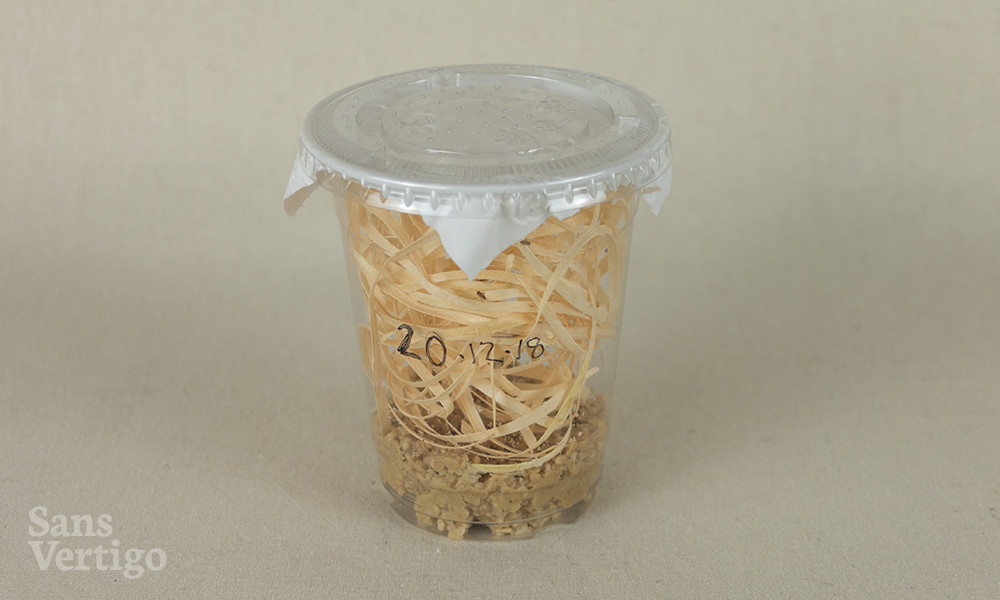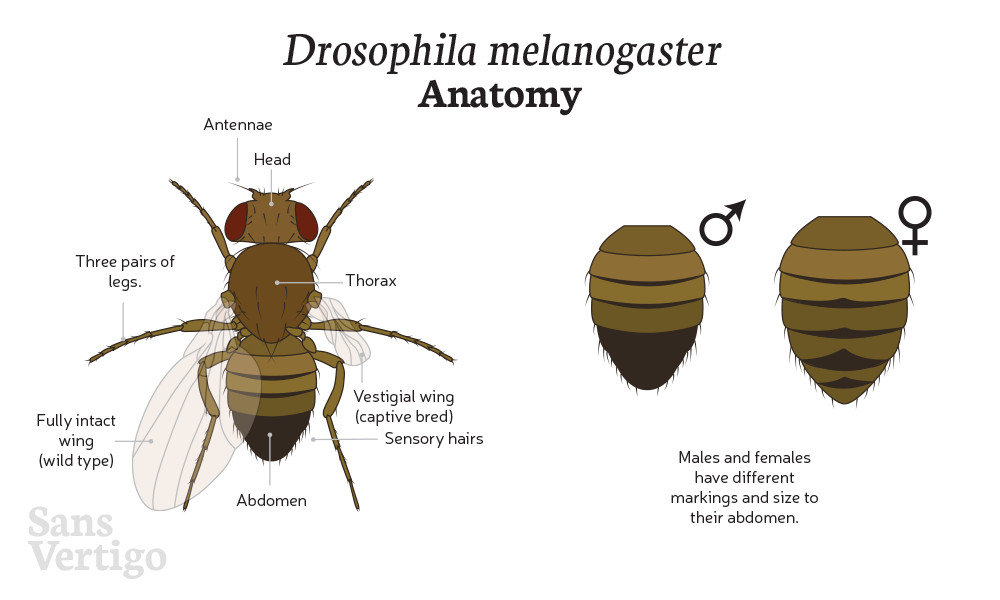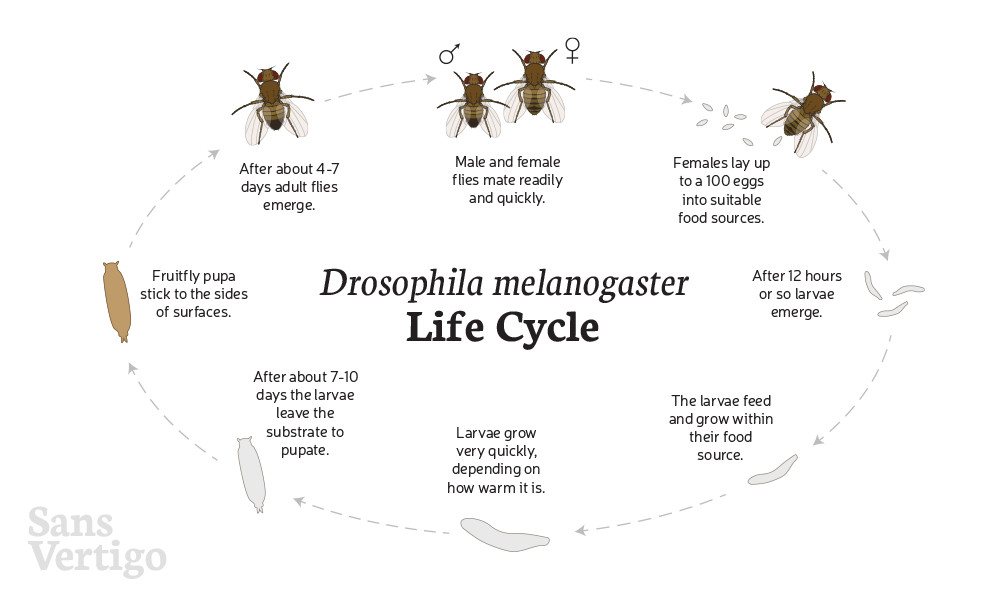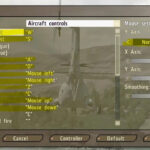Fruit fly care is crucial for hobbyists and researchers alike. At flyermedia.net, we provide insights into managing these tiny insects effectively. This guide will walk you through everything you need to know, from housing and feeding to troubleshooting common issues. Learn how to maintain healthy fruit fly cultures for your various needs. Discover the essentials of drosophila melanogaster care and breeding techniques.
1. Understanding Fruit Flies: Species Profile
Fruit flies, scientifically known as Drosophila melanogaster, are small insects often used as feeder insects for small pets and in scientific research.
- Common Name: Vinegar fly, fruit fly
- Scientific Name: Drosophila melanogaster
- Size: Approximately 2.5mm long
- Lifespan: About 21 days
- Diet: Detritivore; they feed on decaying fruit and vegetable matter.
- Appearance: They are tiny flies with red eyes. Some varieties have vestigial wings, making them flightless.
- Use in Hobby: They are used as feeder insects for small fish, birds, frogs, and invertebrates.
These characteristics make them ideal for both pet owners and researchers.
2. Housing Fruit Flies: Creating the Ideal Environment
What is the best way to house fruit flies to ensure a thriving colony? The ideal housing for fruit flies involves a suitable container, proper temperature control, appropriate substrate, and some decor to facilitate their life cycle.
- Recommended Size: A 425ml cup or jar with a tight-fitting lid that has ventilation.
- Ventilation: Any ventilation should be filtered with filter paper, cloth, or fine mesh to prevent escapes and contamination. Tiny pinholes can also provide sufficient ventilation without a filter.
- Temperature: Keep them out of direct sunlight. Avoid temperatures above 28°C for extended periods, as this can cause them to genetically revert to their flying form. Maintain a temperature between 18-24°C for the fastest possible growth.
- Substrate: Use a 2cm thick layer of fruit fly food mix. You can purchase pre-made lab mixes, use a homemade recipe, or find one online. The larvae feed and grow in this substrate.
- Decor: Add excelsior (wood wool), folded coffee filters, or shredded paper for the adult flies to grip onto. Excelsior is preferable because it doesn’t sag with moisture over time.
 Fruit Fly Housing Setup
Fruit Fly Housing Setup
Proper housing is crucial for maintaining a healthy and productive fruit fly colony.
3. Feeding Fruit Flies: Nutritional Requirements
What do fruit flies eat to thrive and reproduce effectively? Fruit flies require a nutrient-rich substrate for the larvae to feed on, typically made from decaying fruit and vegetable matter or a specialized fruit fly food mix.
The primary purpose of raising fruit flies is to feed them to small animals. To harvest them:
- Tap the upright culture cup on a table to dislodge the flies from the top and sides.
- Remove the lid quickly, continuing to tap the cup if the flies attempt to climb out.
- Angle and tap the cup directly over the enclosure of the animal you wish to feed.
- Replace the lid quickly to prevent escapes and contamination from wild fruit flies.
Feeding frequency depends on the colony size and the needs of the animals you are feeding.
4. Behavior and Biology of Fruit Flies
How do fruit flies behave, and what biological traits make them useful for research and feeding? Drosophila melanogaster is a common species often considered a pest around sweet foods and fruits, but they are only pests in the presence of rotting food.
 Fruit Fly Anatomy
Fruit Fly Anatomy
In captivity, these flies are commonly used in labs due to their short lifespan, ease of breeding, and genetic selection. Varieties with vestigial wings exist, making them easier to handle for both scientists and hobbyists.
5. Fruit Fly Reproduction: Life Cycle and Breeding
How do fruit flies reproduce, and what conditions are needed for successful breeding? The reproduction of Drosophila melanogaster is well-studied, and their sexual preferences and biological development are extensively documented.
- Life Cycle: The life cycle of a single fly typically lasts about 21 days, from egg to death. Warmer temperatures can accelerate this process, while cooler temperatures can slow it down.
- Egg Laying: The female fly can lay up to 100 eggs a day into the nutrient-rich substrate.
- Larval Stage: After about 12 hours, the eggs hatch into tiny larvae that feed on and burrow through the substrate.
- Larval Growth: The larvae grow larger over 7-10 days.
- Pupation: Mature larvae leave the substrate and climb onto surfaces to pupate. In a culture, they can be seen as rice-like pupae on the sides of the cup.
- Emergence: After 4-7 days, adult flies emerge from the pupae, leading to a noticeable population spike.
- Adult Lifespan: Adult flies generally die within 7 days, so it is recommended to start new cultures once a culture starts producing flies. The old substrate cannot be reused.
 Fruit Fly Life Cycle
Fruit Fly Life Cycle
Labeling the date on the container can help track the progress of multiple colonies.
6. Troubleshooting Common Issues in Fruit Fly Cultures
What are common problems encountered in fruit fly cultures, and how can they be resolved? Common issues include grain mites, other pests, mold growth, and the reversion of vestigial wing flies to flying form.
6.1. Grain Mites
Grain mites are a natural occurrence in fruit fly cultures. They typically aren’t an issue unless the culture is older than 4 weeks and not cleaned out. Overpopulation of grain mites can outcompete the fruit flies, causing cultures to fail.
- Solution: Practice good culture hygiene, clean out old cultures, and occasionally wipe down the storage area.
6.2. Other Mites and Pests
Foreign mite species, ants, and wild flies can be attracted to fruit fly cultures as a food source.
- Solution:
- Keep cultures indoors in a space away from potential pests.
- Add extra barriers against pests, such as anti-mite paper, diatomaceous earth, mesh screens, or non-woven poly fabrics.
- Avoid opening cultures where wild flies are present.
6.3. Mold Growth
Mold growth is often due to improper temperatures.
- Solution: Maintain temperatures consistently above 18°C, ideally around 24°C. Additional heating via a heat lamp, cord, or mat connected to a thermostat in an enclosed space can help.
6.4. Reversion to Flying Form
If vestigial wing flies start developing full wings and flying, it may indicate:
-
The temperature of the culture has reached 28°C or higher, increasing the chances of genetic change.
-
Wild fruit flies have entered the culture due to proximity to a wild source.
-
Solution: Discard the contaminated culture, eliminate the cause, and obtain a new flightless culture from a reliable source.
 Fruit Fly Calendar
Fruit Fly Calendar
Regular maintenance and monitoring can prevent many of these issues.
7. Advanced Techniques for Fruit Fly Care and Breeding
What advanced techniques can enhance fruit fly culture maintenance and breeding efficiency?
7.1. Genetic Selection
Selective breeding can enhance desirable traits, such as winglessness or specific genetic markers for research.
7.2. Controlled Environments
Using environmental chambers to maintain consistent temperature and humidity can optimize growth and reproduction rates. According to research from Embry-Riddle Aeronautical University, controlled environments significantly improve the predictability and yield of fruit fly cultures, essential for consistent experimental results and reliable feeder insect production.
7.3. Media Optimization
Experimenting with different food substrates can lead to improved nutrition and higher yields.
7.4. Monitoring Population Density
Regularly monitoring and adjusting population density can prevent overcrowding and maintain a healthy culture.
8. The Role of Fruit Flies in Scientific Research
Why are fruit flies important in scientific research, and what fields benefit from their use? Fruit flies are a cornerstone of genetic and developmental biology research.
8.1. Genetic Research
Fruit flies have been instrumental in groundbreaking genetic studies, including research on gene mapping, mutation, and inheritance.
8.2. Developmental Biology
They are used to study developmental processes, such as embryogenesis and organ formation, due to their rapid life cycle and easily observable traits.
8.3. Disease Modeling
Fruit flies are also used to model human diseases, including neurodegenerative disorders and cancer, due to their genetic similarities with humans.
According to the National Institutes of Health, research on fruit flies has led to significant advances in understanding fundamental biological processes and developing new therapies for human diseases.
9. Sourcing High-Quality Fruit Fly Cultures
Where can you obtain high-quality fruit fly cultures, and what factors should you consider when purchasing them?
9.1. Reputable Suppliers
Purchase cultures from reputable suppliers who guarantee the health and genetic integrity of their flies.
9.2. University Labs
Some university labs offer cultures for research purposes.
9.3. Online Marketplaces
Online marketplaces specializing in feeder insects can be a convenient source.
9.4. Local Breeders
Local breeders can provide cultures adapted to your specific environment.
When selecting a supplier, consider factors such as the age of the culture, the density of the population, and any guarantees offered.
10. Maintaining Genetic Diversity in Fruit Fly Cultures
How can you ensure genetic diversity in your fruit fly cultures to prevent inbreeding and maintain vigor?
10.1. Regular Introduction of New Flies
Introduce new flies from different sources to maintain genetic diversity.
10.2. Avoiding Bottlenecks
Avoid creating bottlenecks where the population size is drastically reduced, as this can lead to inbreeding.
10.3. Subdividing Cultures
Subdivide cultures into multiple lines and periodically mix them to promote genetic exchange.
10.4. Monitoring Traits
Monitor traits and select for desirable characteristics to prevent the loss of genetic diversity.
11. Fruit Flies as a Sustainable Feeder Insect
Why are fruit flies considered a sustainable option as feeder insects, and what are the benefits of using them?
11.1. Rapid Reproduction
Their rapid reproduction rate makes them a sustainable source of food for small animals.
11.2. Low Maintenance
They require minimal space and resources, making them an economical option.
11.3. Nutritional Value
They provide essential nutrients for the growth and health of feeder insect-eating pets.
11.4. Reduced Environmental Impact
Raising fruit flies has a lower environmental impact compared to other feeder insects, such as crickets or mealworms.
12. Fruit Fly Food Mix Recipes: DIY Options
What are some effective DIY recipes for creating fruit fly food mix, and what ingredients are commonly used?
12.1. Potato Flake Recipe
- 1 cup instant potato flakes
- 1/2 cup sugar
- 1/4 cup active dry yeast
- 1 teaspoon methylparaben (mold inhibitor)
- Water
Mix dry ingredients, add water until a paste forms.
12.2. Cornmeal Recipe
- 1 cup cornmeal
- 1/2 cup sugar
- 1/4 cup active dry yeast
- 1 teaspoon methylparaben
- Water
Mix dry ingredients, add water until a paste forms.
12.3. Fruit-Based Recipe
- 1 cup mashed banana
- 1/2 cup sugar
- 1/4 cup active dry yeast
- 1 teaspoon methylparaben
- Water
Mix ingredients, add water until desired consistency.
Always ensure that the mix is not too wet to prevent mold growth.
13. Fruit Fly Genetics: Understanding Mutations
How can understanding fruit fly genetics help in research and breeding programs?
13.1. Mutant Strains
Different mutant strains of fruit flies are used to study specific genes and developmental processes.
13.2. Wingless Strains
Wingless strains are commonly used as feeder insects because they are easier to contain.
13.3. Eye Color Mutants
Eye color mutants are used to study gene interactions and developmental pathways.
13.4. Body Color Mutants
Body color mutants are used to study metabolic processes and pigmentation.
14. Controlling Wild Fruit Flies: Prevention Tips
How can you prevent wild fruit flies from infesting your home or lab, and what control measures are effective?
14.1. Eliminating Breeding Sites
Eliminate sources of rotting fruit and vegetables, which are breeding sites for wild fruit flies.
14.2. Sealing Food
Store food in airtight containers to prevent access.
14.3. Cleaning Spills
Clean up spills and food debris promptly.
14.4. Using Traps
Use fruit fly traps baited with vinegar or wine to capture and kill wild flies.
15. Fruit Fly Evolution: Adaptations
What adaptations have fruit flies developed over time, and how do these adaptations contribute to their survival?
15.1. Rapid Life Cycle
Their rapid life cycle allows them to adapt quickly to changing environmental conditions.
15.2. High Reproductive Rate
Their high reproductive rate ensures that they can quickly colonize new habitats.
15.3. Sensory Adaptations
Sensory adaptations allow them to detect food and mates efficiently.
15.4. Resistance to Toxins
Some populations have developed resistance to toxins in their environment.
16. Ethical Considerations in Fruit Fly Research
What ethical considerations should be taken into account when using fruit flies in research?
16.1. Minimizing Suffering
Minimize any potential suffering by using appropriate handling and euthanasia techniques.
16.2. Justifying Use
Justify the use of fruit flies by demonstrating the potential benefits of the research.
16.3. Complying with Regulations
Comply with all relevant regulations and guidelines for animal research.
16.4. Promoting Transparency
Promote transparency by disclosing the methods used in the research and the potential impact on the flies.
17. Fruit Fly Pests: Identification and Management
How can you identify common pests that affect fruit fly cultures, and what management strategies are effective?
17.1. Mites
Mites are a common pest that can infest fruit fly cultures and compete for food.
17.2. Phoretic Mites
Phoretic mites attach themselves to adult flies and spread to new cultures.
17.3. Nematodes
Nematodes can also infest fruit fly cultures and feed on the larvae.
17.4. Management Strategies
Use barriers, clean cultures regularly, and introduce predatory mites to control pests.
18. Fruit Fly Collection Techniques: Methods for Researchers
What are effective methods for collecting fruit flies for research purposes?
18.1. Aspiration
Aspiration is a common method for collecting flies using a handheld device.
18.2. CO2 Anesthesia
CO2 anesthesia can be used to immobilize flies for sorting and collection.
18.3. Funnel Traps
Funnel traps can be used to collect flies based on their attraction to certain stimuli.
18.4. Light Traps
Light traps can be used to collect flies based on their attraction to light.
19. Fruit Fly Sexing: Identifying Males and Females
How can you differentiate between male and female fruit flies, and why is this important?
19.1. Sexual Dimorphism
Males have shorter abdomens and a distinct black patch on the end of the abdomen.
19.2. Sex Combs
Males have sex combs on their front legs, which are absent in females.
19.3. Abdomen Shape
Females have a more pointed abdomen than males.
19.4. Importance of Sexing
Sexing is important for genetic studies and breeding programs.
20. Using FlyerMedia.net for Aviation Insights
How can FlyerMedia.net help you stay informed about aviation training, news, and career opportunities?
20.1. Aviation Training Information
FlyerMedia.net offers comprehensive information on aviation training programs and flight schools.
20.2. Latest Aviation News
Stay updated with the latest aviation news and industry trends.
20.3. Career Opportunities
Explore career opportunities in the aviation industry.
20.4. Community Engagement
Engage with a community of aviation enthusiasts and professionals.
Maintaining healthy and productive fruit fly cultures requires attention to detail and consistent care. By following these guidelines, you can ensure the success of your cultures for both hobby and research purposes.
FAQ: How To Take Care Of Fruit Flies
1. What is the ideal temperature for fruit fly cultures?
The ideal temperature for fruit fly cultures is between 18-24°C (64-75°F) to ensure optimal growth and reproduction. Maintaining this temperature range prevents genetic reversion to the flying form and minimizes mold growth.
2. How often should I change the substrate in a fruit fly culture?
The substrate in a fruit fly culture should be changed every 4 weeks to prevent mite infestations and ensure a nutrient-rich environment for the larvae. Regular cleaning helps maintain a healthy colony.
3. What are the signs of a fruit fly culture failing?
Signs of a failing fruit fly culture include a decrease in fly population, the presence of mites, mold growth, and the reversion of vestigial wing flies to flying form. Addressing these issues promptly can help revive the culture.
4. How can I prevent mold growth in my fruit fly cultures?
To prevent mold growth, maintain a consistent temperature between 18-24°C, ensure the substrate is not too wet, and add a mold inhibitor like methylparaben to the food mix. Proper ventilation also helps reduce mold.
5. What is the best way to harvest fruit flies for feeding?
The best way to harvest fruit flies is to tap the culture cup to dislodge the flies, remove the lid quickly, and tap the flies directly into the enclosure of the animal you wish to feed. Replacing the lid promptly prevents escapes.
6. How can I tell the difference between male and female fruit flies?
Male fruit flies have shorter abdomens with a distinct black patch at the end, while females have longer, more pointed abdomens. Males also have sex combs on their front legs, which females lack.
7. What type of container is best for housing fruit flies?
A 425ml cup or jar with a tight-fitting lid that has filtered ventilation is best for housing fruit flies. The ventilation prevents escapes and allows for air exchange.
8. What should I do if my vestigial wing fruit flies start to develop wings?
If vestigial wing fruit flies start developing wings, it may be due to high temperatures or contamination from wild flies. Discard the culture, eliminate the cause, and start a new culture with flightless flies.
9. Why are fruit flies used in scientific research?
Fruit flies are used in scientific research due to their short lifespan, ease of breeding, and genetic similarities to humans. They are valuable for studying genetics, development, and disease modeling.
10. How can I maintain genetic diversity in my fruit fly cultures?
To maintain genetic diversity, introduce new flies from different sources, avoid population bottlenecks, subdivide cultures, and monitor traits. These practices help prevent inbreeding and maintain a healthy colony.
Are you fascinated by the world of aviation and eager to explore more? Visit flyermedia.net today to discover a wealth of information on aviation training, the latest aviation news, and exciting career opportunities. Whether you’re dreaming of becoming a pilot or simply have a passion for aviation, FlyerMedia.net is your ultimate resource. Take off into the world of aviation with us now Address: 600 S Clyde Morris Blvd, Daytona Beach, FL 32114, United States. Phone: +1 (386) 226-6000. Website: flyermedia.net.
